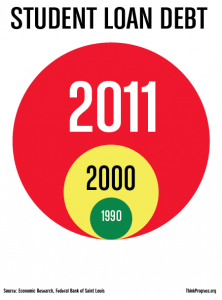 Student loans have been a hot topic in recent weeks as the deadline approached (included in a 2007 law) for the current interest rate for subsidized Stafford loans to double (rising from 3.4% to 6.8%). When Congress passed legislation that continued the very low rate, the topic of student loans was no longer front page news.
Student loans have been a hot topic in recent weeks as the deadline approached (included in a 2007 law) for the current interest rate for subsidized Stafford loans to double (rising from 3.4% to 6.8%). When Congress passed legislation that continued the very low rate, the topic of student loans was no longer front page news.
With this recent issue fresh on the minds of many, a new study provides troubling details of how quickly the amount students are borrowing is increasing. Writing for the Huffington Post, Bonnie Kavoussi reported several of the study’s findings including:
- Since the start of 2005: total student loan debt for borrowers under age 30 has more than doubled
- Since the start of 2005: the average student loan debt for borrowers under age 30 rose over 50%
- The average starting salary for college graduates is now down to $27,000
To put what is happening in perspective, consider what the current level of student debt means in the life of a borrower:
The average starting salary for recent college graduates has plunged 10 percent to $27,000 per year, according to a recent Rutgers University study. It would take 11 years for a borrower with that salary and the average student loan balance of $20,835 to pay off his or her student debt, according to the FinAid loan calculator.
So What?
While experts disagree about the health of the US economy today and projections for what is likely in the near future, it is increasingly important for prospective students to “count the cost” before seeking additional education. Some factors to consider include:
- Unless a seven decade old trend shifts, a greater and greater percentage of the population will attain college degrees in the future.
- Over the last three decades costs for tuition and fees have risen faster than other goods or services, including healthcare.
- Unless the government radically reconfigures its role, it is unlikely that borrowers will receive interest rates in the 3-4% range indefinitely.
- Potential earnings matter, but should not be viewed as the sole or even primary measure of a college education.
- Not only is the new workforce more likely than recent generations to change jobs more often, they are also more likely to change career fields several times during their working years.
- How important is a college education today? Is it more or less important than it was 20 years ago? Is it likely to be more or less important in 20 years than it is today? Why?
- How will dramatic increases in student loan debt likely impact how adults live in the decade following graduation? What are the implications of these shifts for local congregations?